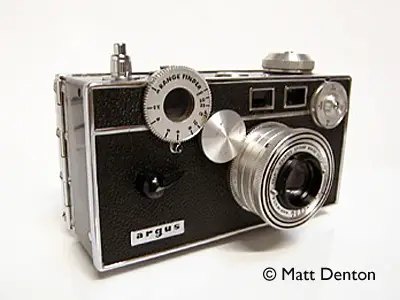- Produced 1938-56 Argus Cameras, Inc., Ann Arbor, MI USA
- Film type 135 (35mm)
- Picture size 24 x 36mm
- Weight 26.8oz (759.8g)
- Lens Argus Coated Cintar 50mm 1:3.5 (3 element)
- Focal range 3′ to infinity
- Shutter leaf
- Shutter speeds B, 1/10-1/300
- Viewfinder coupled rangefinder
- Exposure meter none
- Flash Sync (non-PC)
Overview
Imagine if you will for a moment the stereotypical family vacation slide show that is now part of Americana. Those drawerfuls of slides of Aunt Sarah and Mount Rushmore were very likely taken with the ubiquitous Argus C3. It’s probably the single largest-selling non-single-use 35mm camera in history, which is why you can easily get them in good working condition for $5 – $10 on ebay). Over 2 million were sold during its lifetime, and the story goes that were it not for the popularity of this little steel and bakelite “brick”, who knows what size film we’d be using as standard now instead of 35mm.
I got one for its historical significance and its unique appearance, not to mention the price. Then I got a second – I decided this would be a perfect camera to practice repairs on and got another for parts or spare. The second one, which is older and only cost me $5 is in such great shape it looks like it’s only a year old instead of 40! I ended up performing a successful repair on the first one, which had a hesitating slow speed mechanism. A very satisfying task!
I should also mention that my $5 Argus brick takes pictures that rival some of the ‘finer’ cameras in this collection. The simple and long-lived shutter is accurate, the 50mm coated Cintar lens is brutally sharp and exceptionally contrasty. People talk about getting a Pentax K1000 as a student camera, but if I were teaching a basic photography course to serious students, I think I’d hand them all an Argus C3 and let them REALLY learn how to do it!
The C3 is more versatile than you would think at first glance; the lenses are actually interchangable and you could realistically build a kit around the Brick. A manual I have outlines the use of a telephoto lens (100mm), wide angle lens (35mm), and the Argus Variable Power Viewfinder, which views in 35mm, 50mm, and 100mm with built-in parallax adjustment. My understaning is that Enna-Werk of Germany made the auxiliary lenses for the C3, and I’ve heard that there were others available from Soligor, Fuji, and others, in other focal lengths as well.
Repairs
After seeing the fuzzy pictures the first C3 took I decided a good introduction to camera repair would be to give the shutter a cleaning and check out the insides. They call the C3 the ‘Model T’ of cameras, for good reason. Not too complicated inside…I followed the dismantling instructions found at the Argus Collector’s Group website. It involves taking off the leather, so be careful there. All the important screws are under the front leather. Once I got it all apart I cleaned all the glass and any tarnished brass. Then I got my canister of Radio Shack electronics cleaner (mostly ether in a handy can with brush attachment – don’t take a deep whiff!) and gave a squirt to the slow speed mechanism which it turned out wasn’t releasing properly. Worked it a few times, now good as new! A note here – most camera repair info indicates that very clean parts require no lubrication, they just work together properly when clean, it’s the old grease or dirt making it gummy. Better none at all than too much. In this case none. Getting the leather back on right was actually the hardest part for me, that Pliobond is slippery, tricky stuff. This ‘fixed’ C3 isn’t as pretty now as the other one – not that it was to begin with – but it works much better now, and takes great pictures.
I should note here that if all you need to do is adjust the rangefinder or clean the window glass you can do that by taking off the little ‘door’ over the rangefinder windows, you’ll find adjustment screws underneath and easy access to those little glass windows. Such a straightforward, no-frills design, you’d think it was Ukranian! 😉
Tips & Tricks
My chief complaints about the C3 are the tiny viewfinder and rangefinder windows, and the fact that my finger always seems to get in the way of the shutter lever, which is right on the front of the camera where I’m used to gripping it. The c-four doesn’t have that problem.
The external gearing on this and the c-four make focusing a little slower than on some of the other rangefinders I’ve used — not to mention the separate (and tiny) viewing and focusing finder windows — so zone focusing is probably better for these. The good news: Cintar lenses are sharp, coated and contrasty, and these old Argus leaf shutters seem to last forever, simple and strong as they are. Note too that having a leaf shutter means that it syncs at all speeds, which is very nice, particularly when using fill flash.
My two C3s come from different eras, but the older has a good guide to the ‘Color-Matic’ settings, on a sticker inside the case: ‘YELLOW for Kodachrome, AnscoColor daylight color films (ASA 10), RED for Ektachrome, Anscochrome daylight color films and for Plus X, Supreme, etc., black-and-white films (ASA 32-64), GREEN shutter setting for flash.’ I recommend just sticking to the ‘Sunny f16’ rule…
